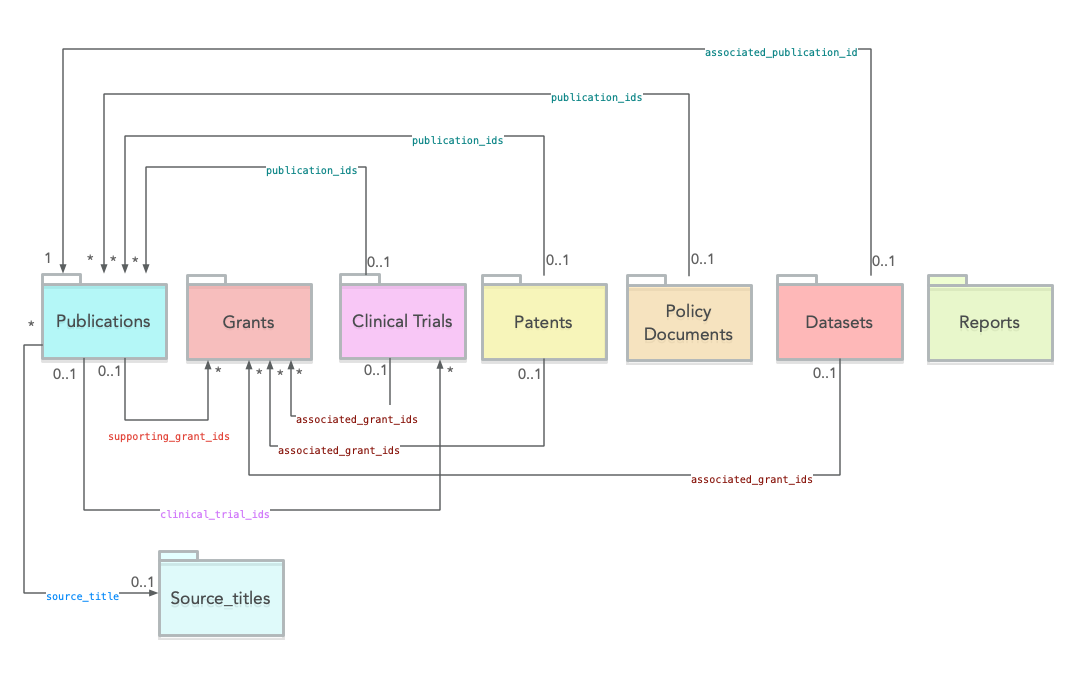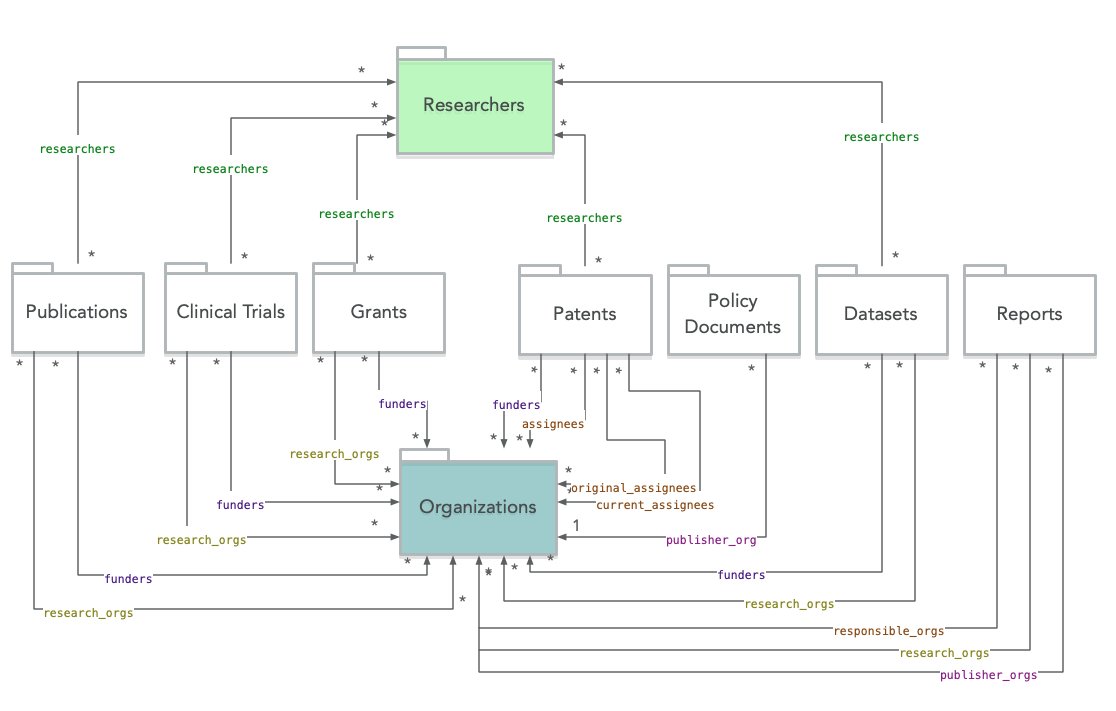Data Sources
This section provides information about each source currently supported by the DSL (version cris-3.1.0) in its default configuration, listing each field available for that source with details about the field value type, including whether it may be used as a facet and whether it is a multi-value field. The page also lists the fields included in each fieldset available for a given source, and each aggregation indicator available for each source.
There are eight primary content types that can be queried via the API:
Two additional sources consist of curated lists of disambiguated researchers and organizations. These objects are referenced in all of the content types above.
The figure below provides an overview of the main document sources and their respective cross links.

The figure below provides an overview of the main relatioships between document sources and researchers / organizations.

Finally, a number of auxiliary entities exists, which cannot be queried directly but are available as structured fields or facets attached to the primary sources. The next
Auxiliary Entities
Auxiliary entities are subsidiary objects that cannot be queried directly, but are available as structured data attached to primary sources via fields or facets.
States
States Literal Fields
Field |
Literal Type |
Multi? |
Filter? Entity Filter? |
Description |
|---|---|---|---|---|
|
✓ ✓ |
GeoNames state name (ISO-3166-2). |
||
|
✓ ✓ |
GeoNames state code (ISO-3166-2). E.g., ‘US.CA’ for geonames:5332921 . |
States Fieldsets
Fieldset |
Fields |
|---|---|
|
|
Repositories
Repositories Literal Fields
Field |
Literal Type |
Multi? |
Filter? Entity Filter? |
Description |
|---|---|---|---|---|
|
✓ ✓ |
The name of the repository of the dataset. |
||
|
✓ ✓ |
Dimensions ID of the repository. |
Repositories Fieldsets
Fieldset |
Fields |
|---|---|
|
|
Publication Links
Publication Links Literal Fields
Field |
Literal Type |
Multi? |
Filter? Entity Filter? |
Description |
|---|---|---|---|---|
|
✓ ✓ |
PubMed ID |
||
|
✓ ✓ |
PubMed Central ID |
||
|
✓ ✓ |
Dimensions publication id |
||
|
✓ ✓ |
Digital object identifier |
Publication Links Fieldsets
Fieldset |
Fields |
|---|---|
|
|
Open Access
Open Access Literal Fields
Field |
Literal Type |
Multi? |
Filter? Entity Filter? |
Description |
|---|---|---|---|---|
|
✓ ✓ |
Name of the open access category. E.g., ‘Closed’ or ‘Pure Gold’. |
||
|
✓ ✓ |
Dimensions ID of the open access category. E.g., one of ‘closed’, ‘oa_all’, ‘gold_bronze’, ‘gold_pure’, ‘green_sub’, ‘gold_hybrid’, ‘green_pub’, ‘green_acc’. (see also the Publications field |
||
|
Description of the open access category. |
Open Access Fieldsets
Fieldset |
Fields |
|---|---|
|
|
Journals
Journals Literal Fields
Field |
Literal Type |
Multi? |
Filter? Entity Filter? |
Description |
|---|---|---|---|---|
|
✓ ✓ |
Title of a journal publication. E.g. ‘Nature’ or ‘The Lancet’ |
||
|
✓ ✓ |
Dimensions ID of a journal. E.g., jour.1016355 or jour.1077219 . |
Journals Fieldsets
Fieldset |
Fields |
|---|---|
|
|
Countries
Countries Literal Fields
Field |
Literal Type |
Multi? |
Filter? Entity Filter? |
Description |
|---|---|---|---|---|
|
✓ ✓ |
GeoNames country name. |
||
|
✓ ✓ |
GeoNames country code (eg ‘US’ for geonames:6252001 ) |
Countries Fieldsets
Fieldset |
Fields |
|---|---|
|
|
Cities
Cities Literal Fields
Field |
Literal Type |
Multi? |
Filter? Entity Filter? |
Description |
|---|---|---|---|---|
|
✓ ✓ |
GeoNames city name. |
||
|
✓ ✓ |
GeoNames city ID (eg ‘5391811’ for geonames:5391811 ) |
Cities Fieldsets
Fieldset |
Fields |
|---|---|
|
|
Categories
Categories Literal Fields
Field |
Literal Type |
Multi? |
Filter? Entity Filter? |
Description |
|---|---|---|---|---|
|
✓ ✓ |
Name of the category. Note: this may include an identifier from the original source. E.g., ‘2.1 Biological and endogenous factors’ (HRCS_RAC codes) or ‘1103 Clinical Sciences’ (FOR codes). |
||
|
✓ ✓ |
Dimensions ID of the category. |
Categories Fieldsets
Fieldset |
Fields |
|---|---|
|
|
Literal Field Types
This section provides information about the most basic field types currently supported by the DSL (version cris-3.1.0).
Field type |
Description |
|---|---|
|
String that represents a precise date. Format is |
|
Floating decimal point number |
|
Whole number |
|
Short piece of text a few characters/words long, e.g. journal issue |
|
Nested unstructured data |
Metadata API
The DSL exposes programmatically metadata, such as supported sources and entities, along with their fields, facets, fieldsets, metrics and search fields.
This is available via the describe command. This can be used in the following ways:
describe- returns list of all sources and entitiesdescribe version- returns information about the DSL version and releasedescribe source <source_name>- returns information about fields, fieldsets, metrics and search_fields of a sourcedescribe entity <entity_name>- returns information about fields and fieldsets of an entitydescribe schema- returns information about all sources and all entities at oncedescribe service <service_name>- returns information about a service. Supported services: grid
For example, the following query will retrieve metadata about all the fields relevant to the publications source.
describe source publications
The metadata is returned as JSON.